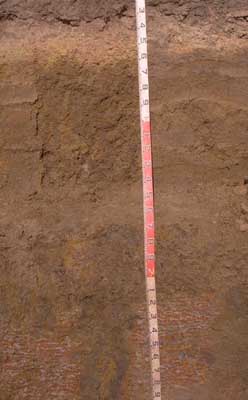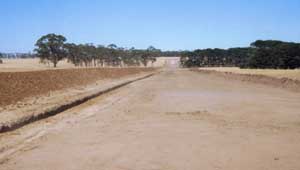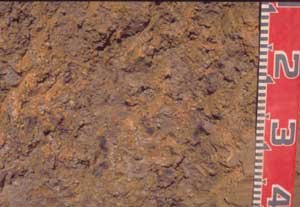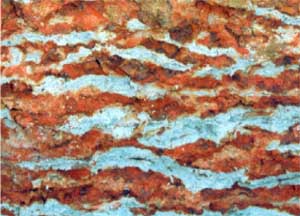SW67
|
| SW67 |  Bleached-mottled (and Reticulate), Eutrophic, Brown CHROMOSOL | |
| Irrewillipie Road / Tomahawk Creek Road—south-west of Colac | |||
| Gently undulating plain | |||
| Neogene Hanson Plain Sand | |||
| Gentle slope above broad plain | |||
| <1% | |||
| South-west | |||
Horizon | Depth (cm) | Description | ||
A1 | 0–10 | Very dark grey (7.5YR3/1 moist), dark greyish brown (10YR4/2 dry); fine sandy loam; weakly pedal structure; weak consistence; pH 5.2; clear and irregular boundary to: | ||
A2 | 40–50/60 | Brown (10YR4/3 moist), yellowish brown (10YR5/4 dry) in upper part of horizon, tending to olive brown (2.5Y4/4 moist), light olive brown (2.5Y5/6 dry); fine sandy clay loam; occasional buckshot gravel in lower part of horizon and some manganiferous mottles or soft concretions; faint rusty mottles (~5 mm); weak consistence; pH 5.8; clear and wavy boundary to: | ||
B21t | 56/60–90/95 | Dark yellowish brown (10YR3/4 moist); with faint yellow and brown mottles; gravelly clay loam; fine polyhedral structure; firm consistence; friable in moist state; few (5–10%) fine to coarse (2–20 mm) rounded ironstone buckshot nodules; pH 6; gradual boundary to: | ||
B22tg | 90/95–120 | Dark greyish brown (10YR4/2 moist); with many (30–50%), yellowish brown (10YR5/8 moist) mottles; thick, dark brown (10YR3/3 moist) cutans; yellow, dull red and black ped interiors; manganese coatings on some ped faces and soft accumulations inside peds; diffuse boundary to: | ||
B23g | 210/300 | Dark brown (10YR3/3 moist), common (<20%), yellowish brown (10YR5/8 moist) mottles with few (5-10%) coarse (~20 mm) soft and hard manganiferous concretions; broad tongueing (300 mm) into B/C horizon; pH 6.3; clear to abrupt boundary and tongueing into: | ||
B/C | 210/300+ | Conspicuous reticulate laminar mottling; ‘tiger mottles’, red (10R4/6) and grey (2.5Y6/1); lamellae 10-20 mm apart; red matrix is rigid strongly cemented ferruginised sand, grey lamellae are soft sandy to clay; margins of lamellae are often yellow (10YR7/8) to yellowish brown (10YR5/8), red matrix frequently presents as angular ironstone gravel (10-20 mm). | ||
| Management considerations | ||||
| The topsoil is very acidic and would benefit from liming to raise pH and reduce the effects of Aluminium toxicity (130 ppm in the surface soil). Topsoil structure is weak and breaks down to a ‘floury’ consistency if cultivated when dry. The A2 horizon is very weak (“spewy) when wet and hard when dry. The presence of buckshot gravel is a variable feature in these soils across the district—in this instance there is only minor gravel and it is deeper in the profile. The gravel can assist with drainage but presents a hazard to tillage implements due to abrasion. The subsoil is substantially heavier in texture than the topsoil and presents a barrier to downward percolation of water when the soil is saturated and this can aggravate and prolong the occurrence of ‘spewy’ conditions in the A2. | ||||
Analytical data
Site SW67 | Sample depth | pH | EC | NaCl | Ex Ca | Ex Mg | Ex K | Ex Na | Ex Al | Ex acidity | FC (-10kPa) | PWP (-150kPa) | KS | FS | Z | C | |
Horizon | cm | H2O | CaCl2 | dS/m | % | cmolc/kg | cmolc/kg | cmolc/kg | cmolc/kg | mg/kg | cmolc/kg | % | % | % | % | % | % |
A1 | 0-10 | 5.2 | 4.4 | 0.09 | N/R | 2.1 | 0.86 | 0.11 | 0.22 | 130 | 17.0 | 23.7 | 9.0 | 8.8 | 53.6 | 13 | 18.0 |
A2 | 40-50 | 5.8 | 4.8 | <0.05 | N/R | 2.1 | 0.88 | <0.05 | 0.08 | 18 | 6.9 | 20.3 | 7.0 | 11.5 | 54.7 | 12.5 | 18.5 |
B21 | 70-85 | 6.0 | 5.2 | 0.06 | N/R | 2.8 | 7.3 | 0.12 | 0.45 | <10 | 12.0 | 37.4 | 25.4 | 3.5 | 21.0 | 7.0 | 67.0 |
B22 | 120-140 | 6.3 | 5.4 | 0.06 | N/R | N/R | N/R | N/R | N/R | N/R | N/R | N/R | N/R | N/R | N/R | N/R | N/R |
 Landscape view, south-west from SW67 site (pipeline easement March 1999) |  Weathering in subsoil—dark manganiferous mottles in B22 (1.2 m) |



